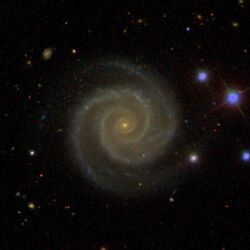Astronomy:NGC 2857
| NGC 2857 | |
|---|---|
 SDSS image of NGC 2857 | |
| Observation data (J2000 epoch) | |
| Constellation | Ursa Major[1] |
| Right ascension | 09h 24m 37.698s [2] |
| Declination | +49° 21′ 25.69″ [2] |
| Redshift | 0.016301 ± 0.000023 [3] |
| Helio radial velocity | 4887 ± 7 km/s [3] |
| Galactocentric velocity | 4917 ± 7 km/s [3] |
| Distance | 69.050 ± 00 kpc (225.21 ± 0.00 kly)h−10.73 [3] |
| Apparent magnitude (V) | 12.27 [2] |
| Apparent magnitude (B) | 12.90 [2] |
| Absolute magnitude (V) | -21.92 ± 0.22 [3] |
| Characteristics | |
| Type | SA(s)c [3] |
| Size | 125,000 [1] |
| Apparent size (V) | 1.70′ × 1.43′ [3] |
| Other designations | |
| NGC 2857, Arp 1, APG 1, PGC 26666, UGC 5000 | |
NGC 2857 (also known as Arp 1 and PGC 26666) is a spiral galaxy in the constellation Ursa Major. It was discovered on January 9, 1856, by R. J. Mitchell.[1]
NGC 2857 is the first object in Halton Arp's Atlas of Peculiar Galaxies, and one of six Arp objects in the 'Low Surface Brightness Galaxies' section. The other five low surface brightness galaxies are Arp 2 (UGC 10310), Arp 3, Arp 4, Arp 5 (NGC 3664), and Arp 6 (NGC 2537).[4]
On October 10, 2012, supernova SN 2012fg was observed in NGC 2857 by the MASTER-Kislovodsk auto-detection system.[5][6] Its absolute magnitude was calculated to be -19.8.[7] The spectrum of SN 2012fg was recorded and analyzed by multiple teams of scientists as it changed rapidly in the days following its detection.[8][9]
References
- ↑ 1.0 1.1 1.2 Seligman, Courtney. "New General Catalog Objects: NGC 2850 - 2899". http://cseligman.com/text/atlas/ngc28a.htm#2857.
- ↑ 2.0 2.1 2.2 2.3 "SIMBAD Astronomical Database". Results for NGC 2857. http://simbad.u-strasbg.fr/simbad/.
- ↑ 3.0 3.1 3.2 3.3 3.4 3.5 3.6 "NASA/IPAC Extragalactic Database". Results for NGC 2857. http://www.ned.ipac.caltech.edu/.
- ↑ Arp, Halton (1966). "Atlas of Peculiar Galaxies". https://ned.ipac.caltech.edu/level5/Arp/Arp_figure1.html.
- ↑ Pruzginskaya. "ATel #4489: Folow [sic] up B,V,R,I photometry bright SN 2012fg in NGC 2857 discovered by MASTER". http://www.astronomerstelegram.org/?read=4489.
- ↑ Shumkov. "ATel #4459: Bright PSN in NGC2857". http://www.astronomerstelegram.org/?read=4459.
- ↑ Cellier-Holzem. "ATel #4466: Spectroscopic Observation of the Bright PSN in NGC2857 by the Nearby Supernova Factory II". http://www.astronomerstelegram.org/?read=4466.
- ↑ Fabrika. "ATel #4496: Spectrum of bright SN 2012fg in NGC 2857". http://www.astronomerstelegram.org/?read=4496.
- ↑ Fabrika. "ATel #4520: Spectrum change of bright SN 2012fg in NGC 2857". http://www.astronomerstelegram.org/?read=4520.
External links
- Full Arp Atlas
- Halton Arp's image of Arp 1
- Constellation Locator
- SIMBAD Astronomical Database
- NASA/IPAC Extragalactic Database
- SN 2012fg detection announcement
Coordinates: ![]() 09h 24m 37.698s, +49° 21′ 25.69″
09h 24m 37.698s, +49° 21′ 25.69″
 |

